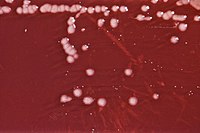
Photo from wikipedia
Background: In the present study a statistical model (Response Surface Methodology) was proposed for optimization of siderophore production by using Enterobacter hormaechei.Methods: The rhizospheric soil was used for isolation and… Click to show full abstract
Background: In the present study a statistical model (Response Surface Methodology) was proposed for optimization of siderophore production by using Enterobacter hormaechei.Methods: The rhizospheric soil was used for isolation and isolates were screened for siderophore production by chrome-azurol S (CAS) assay. One potent isolate producing maximum siderophore was selected and characterized by 16S rRNA gene sequencing. The culture conditions were optimized for maximum siderophore production by using Central Composite Design. The response surface curves were used to predict the optimum levels of the factors affecting the yield of siderophore. Result: By using rhizospheric soil,eight isolates were obtained and one potent organism was identified as Enterobacter hormaechei subsp. oharae (Accession No. MT 775835) by BLAST. The maximum siderophore production (98%) was obtained in succinate medium and the optimum values of variables were found as pH 7, time 60 hrs, temp. 28°C and succinic acid conc. 0.40%. RSM was used to analyze the data by developing 3D surface plots and the residuals plots. ANOVA was used to determine regression coefficients.
Journal Title: Indian journal of agricultural research
Year Published: 2021
Link to full text (if available)
Share on Social Media: Sign Up to like & get
recommendations!